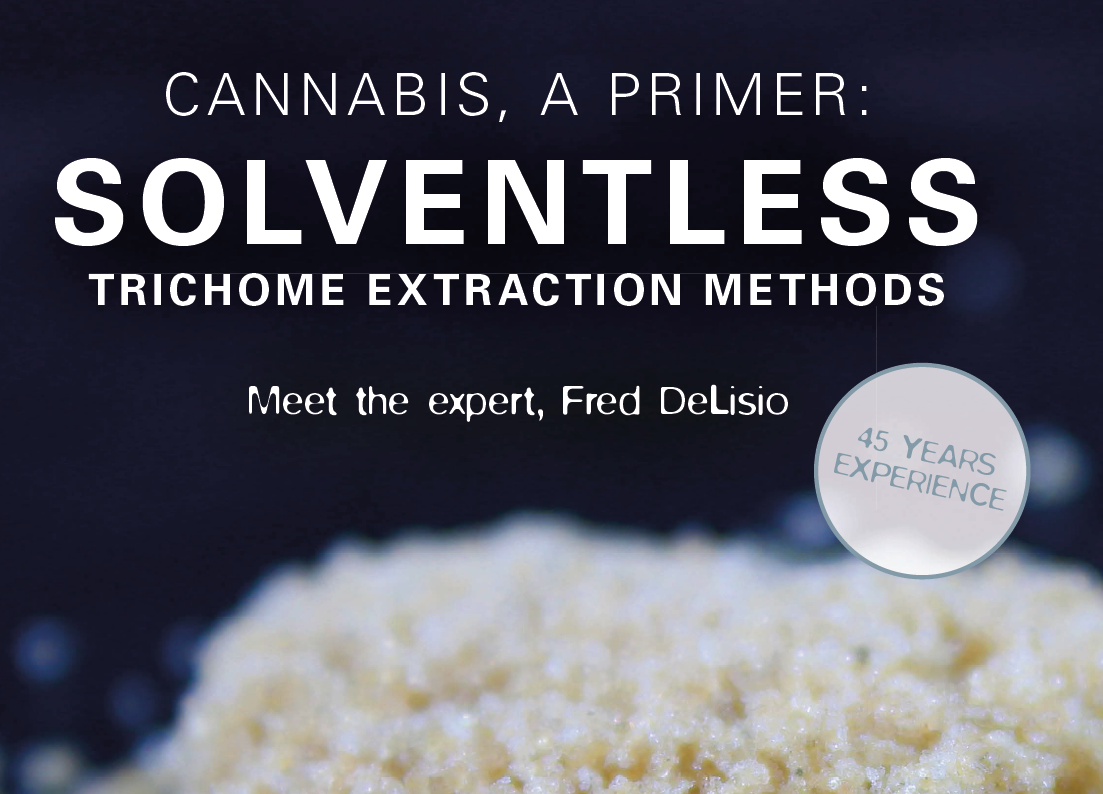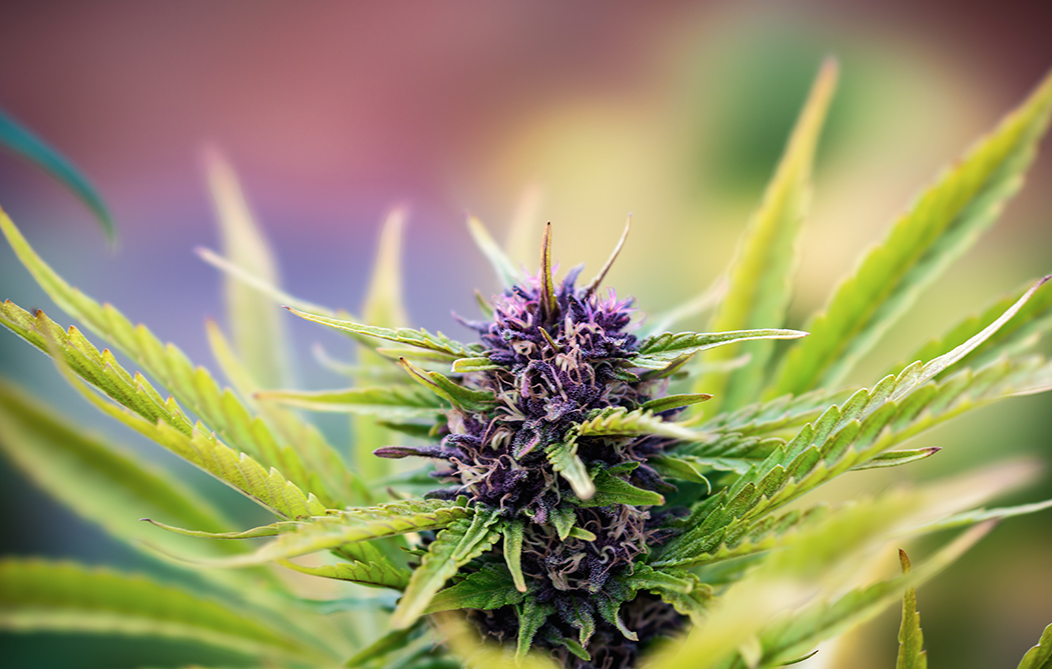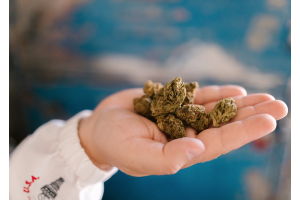Cannabis, A Primer: Solventaless Trichome Extraction Methods, Meet the expert, Fred Delisio

Cannabis has been cultivated for more than 15,000 years..
Cannabis has been cultivated for more than 15,000 years, as we've covered before here, the word "sativa" comes from the Latin word, "sativus" (sativa, sativus, and sativum), meaning "cultivated", the world's first cultivated crop.
This illustrates how important this plant was to early civilization.
It has been used in foodstuffs, as medicines, for clothing, shelter and rope, to sail the seven seas, just to name a few.
So, Hand-Rubbed Hash
One of the earliest, and simplest methods, is hand rubbing, but since it is one of the oldest and most primitive methods, it's more wasteful, and the most manual, basic method.
This is the only method that is done to the plant before harvest, while still alive and growing.
What is being done, is the rupturing of the trichome heads, and the transfer of the oils contained inside, to your hands.
A very primitive and, frankly, wasteful method, because as soon as the trichome head is ruptured, terpenes, esters, flavonoids and cannabinoids all begin to degrade, and evaporate, as you rupture the trichome heads.
This method is simply to place your hands on either side of a mainstem bud, and begin rolling it in between your hands, gently, at first, and then with increasing pressure
This immediately makes your hands the perfect harvesting tools, as the sticky oils coating your hands quickly pick-up more oil and trichomes, and the more your hands become coated, the easier the trichome heads adhere and are harvested.
The more material that collects on your hands, the better, so keep at it, as it is much easier to remove, the thicker your hands are coated.
Then, the newly-collected hash is then rubbed and scraped off your hands.
First, any traces of plant material bits, leaves and debris is removed by lightly, gently brushing your hands together, harder at more tenacious pieces. Then, begin rubbing your hands together over a bowl or collection surface, vigorously, and as the extracted material heats-up, it begins to roll off your hands in strings, balls and chunks, and then lightly brushing your hands together will begin to dislodge the hash.
That is about all there is to collecting hand-rubbed hash, collected while the plant is still growing.
Onward.
So, you've finished growing your beautiful, aromatic cultivars, and have them hanging to dry.
You want to make concentrate from them, and are contemplating what method to use.
You could wash them in ethanol, or extract using light-hydrocarbons (propane, butane), but there is a big push these days for solventless extractions, and rightly so.
Don't get me wrong, there is nothing wrong with solvents, they are used every day in laboratories around the world, and, because the final product is devoid of any and all solvents when it exits the lab, there is absolutely nothing unhealthy about these methods.
However, for home extractions, especially, not having to deal with, or introducing any solvents to begin with is the simplest solution.


Introducing, 'Gumby' Hash
A very simple method, I've done it for decades, since the '70s.
Put a half ounce or so of cannabis buds in a Mason jar, fill it with ice and water, let it soak for 15-30 minutes, to allow the plant material to soften and loosen-up, and then shake it every few hours, adding ice if needed.
This can be done in ambient temperature, or storing the jar in the refrigerator between shakes.
Then, stick it in the refrigerator, and let it stand overnight, shake it again, and let it settle.
Plant material floats, and trichomes settle to the bottom -- it's simple physics.
Then, spoon out the plant material floating on top, gently pour out most of the water, and swish the rest around, and pour it out on a coffee filter, or 25-micron mat to dry.
I LOVE this method, as I can bang out fresh hash overnight, and never need to make more than I need at one time.
But for the folks that grow their plants outside, once a year, and then harvest, and dry/cure, in preparation for processing into hash, all at once, the simple bubble bag method is the most widely used today.
Generally, “bubble bags” are mesh bags, in 1-gallon, 5-gallon and larger mesh bags (the best are all mesh, but some manufacturers only have mesh bottoms on the bags).
The micron sizes are, generally, 220, 190, 160, 120, 90, 75, 45, and 25 (with some variations, but generally, this is it).
They go, in order, one inside the next, with the largest being the top bag, and the smallest mesh being the bottom bag.
They are available from many sources, and easily obtained for a modest sum.
Then, the process is very much like the gumby hash method, but instead of shaking you’re gently agitating the material, after a 20-30 minute soak. (they actually make washing machines that do the agitation for you, they are very common and easy to find, and affordable, as well).
I use 5-gallon bags, because they fit perfectly into 5-gallon buckets that any home improvement or hardware store carries.
I use a wash bucket, and a sieving, or bag bucket with my bags already inserted in, to make things as easy as possible.
Fill the wash bucket halfway with ice-cold, clean water, either distilled or filtered/RO, and then make sure to layer your material in your wash bucket, a layer of material, a layer of ice cubes and repeat.
I only wash about 300-400 grams of material at a time in 5-gallon buckets, to optimize the process.
Once your material is loaded into the ice and water mixture, and thoroughly wet, let stand and soak for 20-30 minutes, adding Ice as needed, before beginning to gently stir/agitate with a wooden spoon.
The more gentle you are with this process, the less plant material will end up in your final product.
Do this for 5-7 minutes, moving the material around, side-to-side, top-to-bottom, being as thorough and as methodical as possible to maximize your trichome harvest, while minimizing the fracturing of the plant material.
Next, simply pour the entire contents into your bucket with the bags in it, swishing the last of the contents before emptying your “wash” bucket into your “bag: bucket.
Your 220 mesh bag (the first one, on top), will catch all of your remaining ice cubes and plant material and as the trichome-laden water drains through the various bags, it will automatically “grade” your hash by micron size.
Your 90-micron bag will catch the trichomes that pass through the 120-micron bag, and your 75 will catch the next smallest, and your 45-micron bag will end up with the “sweet-spot” sizes of trichomes.
I separate the bags, and one at a time, rinse them into the next smaller one with fresh cold water, and then, I use a large spoon to collect the results of each bag, and spoon it onto a 25-micron mesh mat, with paper towels under it, to sit and dry for a bit, before moving on to the next step.
Now, I’m an old-school type of guy, so, once the various grades of hash are inspected and somewhat dry, here is where I would combine the three best-looking piles into one (usually the 120, 90 and 75), and place on parchment paper, on cardboard or a pizza box, and put into my frost-free freezer to complete the drying process.
There are new methods of freeze-drying with a freeze-dryer or “lyophilizer”, however these machines start at thousands of dollars, and for home-use, unless you are also using it to freeze-dry foods and such, are incrementally better, but not worth the price, for home growers, in my opinion.
Here's where my story ends..
As now you are free to vaporize your hash product, dab it, or press it into rosin.
Personally, I LOVE hash, the taste, the smell, and the effect, and it's plenty strong enough for me, without pressing it into rosin, and dabbing.
I prefer lower-temp vaporization, to savor all of the flavors.
Have FUN with hashish, whatever you do with it, stay safe, and be well.
Written and Published By Fred Delisio in Weed World Magazine issue 150












Validate your login